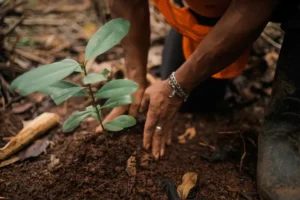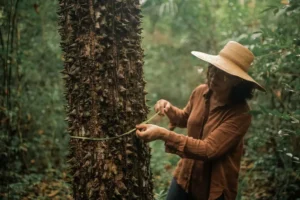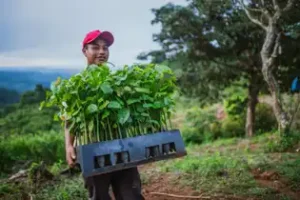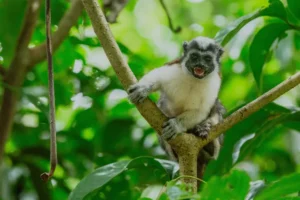
Can rainforests be protected by cutting down trees?
On the ground, a jaguar roams almost silently through the dense vegetation. One level above, two colorful macaws croak in the branches of the tropical trees. On the highest level, in the treetops of the rainforest canopy, you’ll find sloths alongside leaf-eating insects, poison dart frogs, and tree snakes.
All of these animals are native to Panama – and thus part of one of the richest ecosystems in the world: the tropical forest. Around 40 percent of the country is covered by it. Up to 400 different animal and plant species can be found on one hectare. What’s special about them is that they include many endemic species, meaning animals and plants that are found only here in the world. The biodiversity of the Panamanian forests is greater than in any other Central American country.
The value of tropical forests
Tropical forests near the equator are known for their exceptionally high biodiversity. They are of great importance for global biodiversity, as more than half of all land-based animal and plant species live in tropical forests—even though they cover only eight percent of the Earth’s land area.
The reason: high temperatures and sometimes heavy rainfall prevail there year-round – ideal conditions for the emergence of new species and the flourishing of flora and fauna. The Central American forests, with their rich variety of diverse ecological niches, are a paradise for a wide variety of species. There are so many that researchers can’t keep up with describing the new ones.
However, these important ecosystems have been extremely threatened for decades by climate change and human intervention: between 1990 and 2015 alone, 290 million hectares of original forest disappeared; in Panama, this amounted to around 70 percent of the country’s forest area. Deforestation for cattle ranching is the most common reason. For the locals, their forests appear worthless because they cannot earn money from them. This raises one of the greatest problems of our time: How can we reconcile ecological action with economic benefit?
How generational forests can help
Andreas Eke and Iliana Armién have an answer to this question. The Hamburg geographer and the Panamanian forestry engineer founded the cooperative The Generation Forest in 2016 , drawing on 26 years of experience in sustainable tropical reforestation. Since then, they have made it their mission to reforest cleared forest areas in Panama – with generation forests. This means planting new tree species of interest for international trade on predominantly deforested areas. Members of the cooperative can purchase forest land and earn money from the sale of the timber – thus protecting and enhancing the value of the forest.
The Generation Forest


Eke and Armién are calling for a rethink in economics—toward a more sustainable economy that takes climate and environmental protection into account. The key to this: biodiversity. Preserving and expanding this is particularly easy in tropical forests, as their favorable habitat conditions allow them to regenerate quickly in terms of biodiversity. Their high biodiversity also makes forests effective at combating global climate change and the most successful at removing CO2from the atmosphere.
Biodiversity is also worth protecting because of the ecosystem services it provides, without which we humans could not live on this planet. These include, for example, the provision of food, medicinal substances, and recreational areas. If tropical forests are cleared, the consequences can be disastrous for our climate and life on Earth: Without tropical forests, the world would be up to one degree Celsius warmer.
A symbiosis of economy and ecology
Armién and Eke believe that a combination of economics, ecology, and social impact is important to their Generational Forest. With 26 years of experience in sustainable reforestation of tropical forests through their own forestry company, Eke and Armién are familiar with the conditions of the cleared areas. They deliberately do not want to establish a tropical timber plantation. Eke explains: “Plantations do not protect the soil; they deplete it. They also do not serve as habitats.” This means that they are not a solution for restoring tropical forest landscapes.
A permanent, sustainably growing mixed forest with a strong biodiversity instead of a short-term, profitable monoculture – that’s the vision of The Generation Forest. “Are we doing this to make money or to save the world? The great thing is, we don’t even need to differentiate. We do both,” says Eke about the project.

Green climate protectors: One hectare of generational forest binds 20 tons of CO₂ every year.
photo by The Generation Forest / Emir Lebedev
To realize their vision, Eke, Armién, and their team are planting native hardwoods such as mahogany, rosewood, and Spanish cedar on deforested land. Twenty different tree species ensure diversity and greater resilience of the forest to climate change. Armién plants them in her nursery using seeds cultivated over the years.
After twelve years, the first commercial thinning of the Generation Forest begins. Strong trees are given more space, and new seedlings are planted. “By planting the next generation of trees early, after the first thinning, a multi-level ecosystem modeled on the rainforest is formed. This ecosystem remains intact even after individual trees are removed,” says Armién.
Due to the favorable local conditions, tropical forests grow up to four times faster than European ones. As a result, an intact ecosystem has developed in the Generation Forest after just 20 years – with young and older trees of various species. Even the animals displaced by deforestation are returning and, by spreading seeds, ensuring that more plants can grow. The team was particularly surprised when a pair of jaguars was spotted in an environmental organization’s camera trap. “That’s when we knew our plan had worked,” recalls Eke.

A small wigwam monkey perches on a forked branch. Panama’s forests are home to over 400 animal and plant species.
An investment that is worthwhile not only for the investor
In addition to the ecological and economic components, the project also supports a social factor: The more people invest sustainably in The Generation Forest, the more forest area can be reforested – which in turn creates urgently needed jobs in the area. “We train some of our indigenous workers, others even study,” explains Eke. Fair wages and long-term jobs form the basis of the collaboration.
Through the training they receive in the project, locals are transferring their newly acquired knowledge to their own forest areas – from which they can now also earn money. Finding people to imitate and support the project is a major goal for Armién and Eke.
The Generation Forest has now launched nine reforestation projects in the Darién and Colón regions. The cooperative aims to have reforested at least 1,000 hectares of tropical forest by the end of 2022. Andreas Eke concludes: “Together, we can realize further major projects and reverse the decades-long trend of deforestation. We can finally cover this wonderful planet with abundant forest again” – for greater biodiversity, climate protection, and a rethinking of economics.